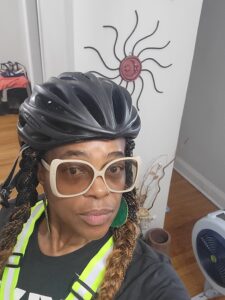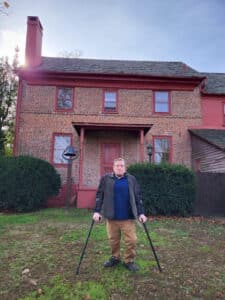In Princeton, It’s Two Steps Forward, One Step Back: ‘Sharrow-ing’ A Vision for Complete Streets
by Cyndi Steiner and Aaron Hyndman

It was all so tantalizingly close. Back in January, Princeton’s bike advocacy groups had secured action from the Town to initiate the process of installing bike lanes on Hamilton Avenue, the Town Council voting 5-to-1 to embark on the beginning of what would hopefully be an extensive network of bike lanes throughout Princeton. But then came the complaints from Hamilton Avenue residents, voicing their opposition to a plan that would take away their ability to park cars on the street in front of their houses. It didn’t matter that the homes that lined Hamilton all included lengthy driveways with the capacity to park several cars off of the roadway. The residents had made their desires known, causing the Town Council to back away from the original plan. Princeton instead opted to not only keep the curbside parking on the south side of Hamilton Avenue, but also to paint sharrows on the north side instead of a bike lane. This sudden reversal was a devastating blow to Princeton’s bike advocates.
The inclusion of sharrows was intended by Princeton officials as a compromise, but to the town’s bicycling advocates, this compromise hardly seems like much of a concession to the cause of encouraging more bike riders to take to the roads. “We recommended bike lanes, to let ‘interested but concerned’ cyclists feel safer on the road,” said Sam Bunting, a citizen member of the Princeton Traffic and Transportation Committee, to NJBWC. “[Town] Council got half-way to approving those bike lanes, but ultimately opted for an unworkable compromise.”
To Steve Kruse, chairman of the Princeton Pedestrian & Bicycle Advisory Committee, the decision was a clear step in the wrong direction. “We are collectively going to nowhere, and short-changing our kids,” said Kruse in a statement to NJBWC. The reality is that sharrows might seem to be a workable alternative, but as far as safety goes, they pale in comparison to the amenities provided by a bike lane, particularly for children who ride bicycles. Furthermore, the rider who is comfortable using a bike lane is not necessarily the same rider who will use sharrows. Therefore, this design leaves those riders with no way back.
Princeton Mayor Liz Lempert describes the currently agreed-upon situation as the best possible alternative. Detailing the town’s plans to NJBWC, Mayor Lempert explained, “I am hoping that in addition to sharrows we can stripe the 7′ parking lane and 3′ shoulder on the opposite side of the road. It’s obviously not the same as bike lanes, but it will define 10′ lanes which will help to slow traffic, and give bikers room in the 7′ space where there are often no cars parked.” Nonetheless, Mayor Lempert noted the frustration many have felt with the lack of progress on installing bike lanes in the town. “Our efforts in Princeton to slow cars and make our streets safer and more welcoming for walkers and bikers have felt at times like one step forward, two steps back,” said Mayor Lempert. “That said, I think we have been making progress in grappling with complete streets.”
While this compromise might seem to town officials like an adequate accommodation for bike riders, the fact of the matter is that it does very little to encourage biking along Hamilton Avenue. A guiding principle of bike infrastructure is that “if you build it, they will come.” Conversely, if you don’t build it, it’s highly unlikely that numbers of bike riders will build up to the critical mass that is needed to have an impact not only on traffic circulation, but also on bicyclist safety. And as Kruse further describes, that leaves the town in that vicious spiral of opponents who complain that traffic speeds need to be reduced, and therefore parking should be preserved to provide traffic calming, yet who also oppose the bike lanes that would provide the needed traffic calming and also provide an additional transportation option. It should also be noted that when no cars are parked on the road, which is regularly the case on a street such as Hamilton, there are no traffic calming effects. On the other hand, when bike lanes are installed, the traffic calming effect is ever-present.
Municipal policy needs to encourage riding, not serve as a barrier. When a town makes an obvious decision to favor the occasional demands of automobile parkers over the consistent needs for safe biking thoroughfares, it sends a terrible message. What people see is that bike riding is not an essential part of a community’s transportation policy, and that bike riders are second class citizens to car drivers.
Time and again, studies show that there is no better way to encourage biking than to build networks of safe bike lanes for riders to navigate through towns, cities and suburbs. The benefits are many. A decrease in traffic congestion, improved health outcomes, and a less-polluted environment are three of the major positives to having a thriving population of bike riders. But for this to happen, there needs to be a substantial population of bicyclists who ride not just for recreation, but as active transportation. Without an adequate network of bike lanes, this can’t be realized.
It’s time for municipalities to do more than just pay lip service to their complete streets policies. Sometimes, that means making tough choices. But when it all comes down to it, the benefits of the greater good have to outweigh the demands for luxuries such as excess curbside parking in addition to off-street parking that already satisfies an abundance of residents’ parking needs.
The roadway is a public good; its intended purpose is to provide a thoroughfare for traffic. Any other use, such as parking, needs to be viewed not as essential, but secondary. Public officials are recognizing the fact that bike lanes have a positive impact our communities. While it’s easy to express support for bicycling infrastructure in theory, in practice, implementing these good ideas takes a bit of fortitude. The time is now for local officials to step up to the plate and follow through on their good intentions, and put the promises to the pavement, giving our communities the bike lanes that are sorely needed. It’s a great first step that Princeton has made the commitment to develop a Bicycle Master Plan. But it can only go so far without the resolve to turn the plan into a reality.
Cyndi Steiner is the Executive Director of the New Jersey Bike & Walk Coalition. Aaron Hyndman serves as the organization’s Communications Coordinator.
[Ed. note: A previous edition of this post stated that the parking ordinance/bike lane plan for Hamilton Avenue had been given the “approval” of the Town Council. The post has been corrected to appropriately reflect that the Town Council’s vote had simply initiated the process, without granting final “approval” of the ordinance.]














































































